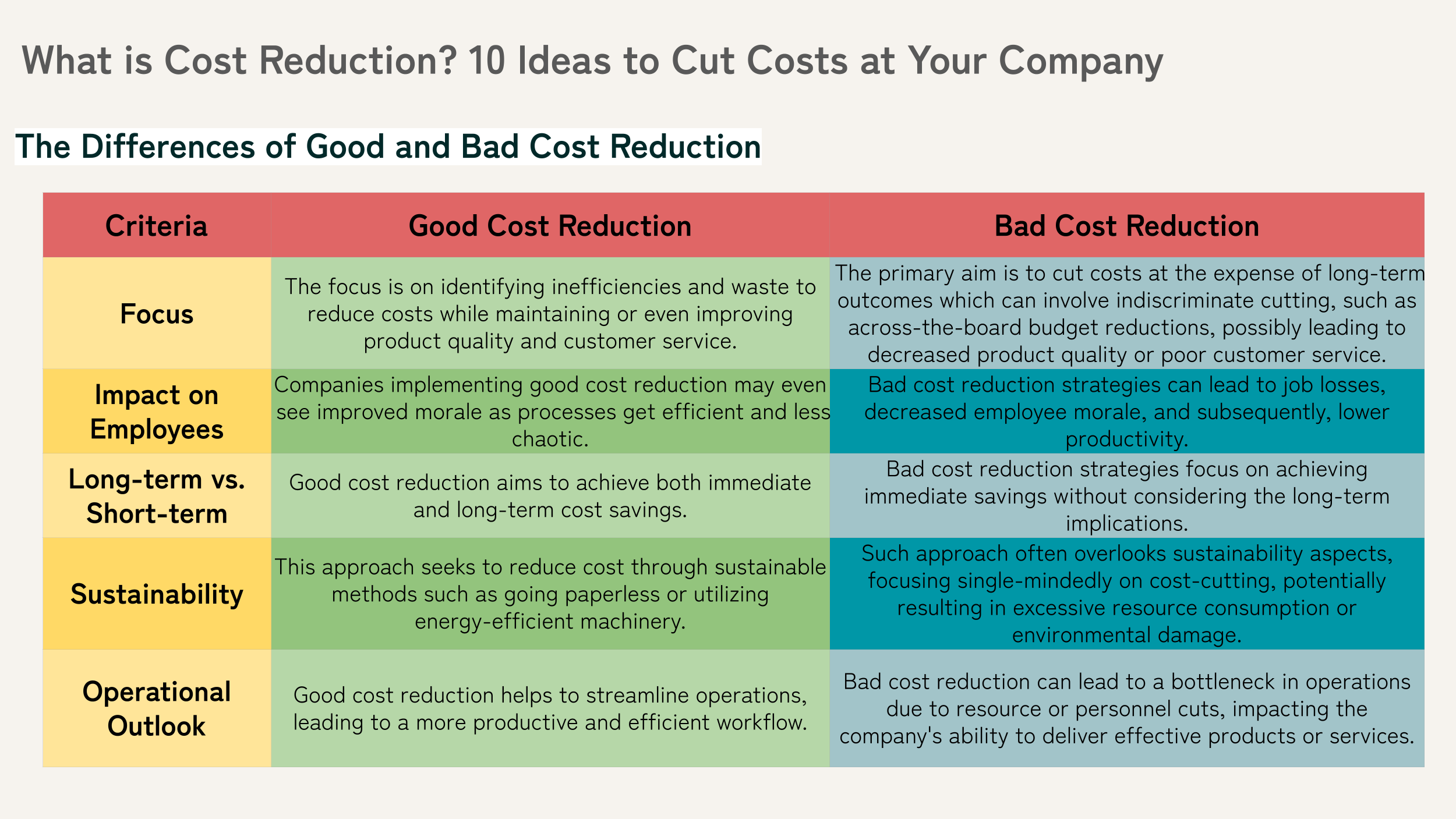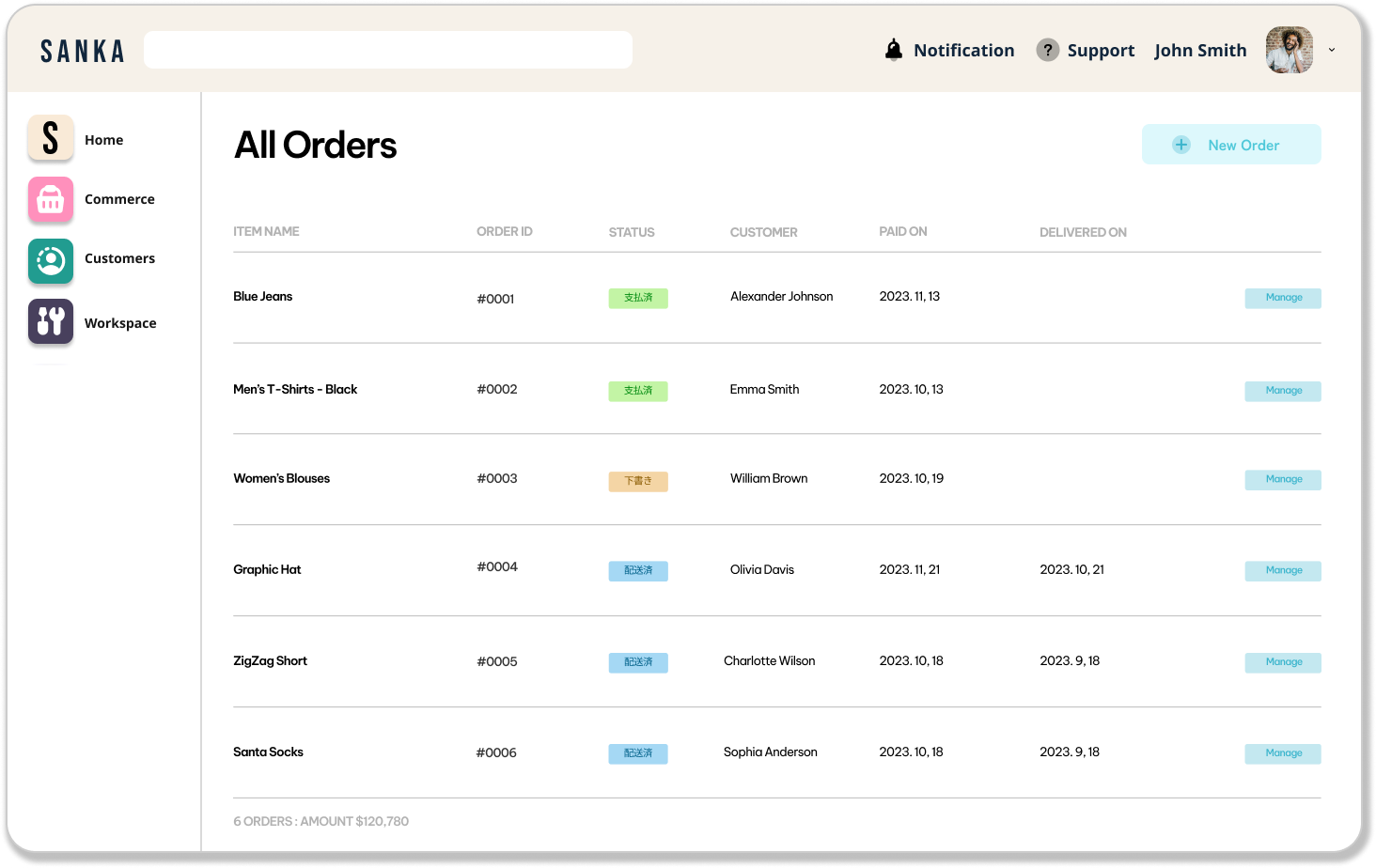Introduction
In today's fast-paced and competitive business environment, achieving cost reduction without harming the company's productivity or product's quality is the key to a healthy bottom line.
Managers are constantly hunting for areas where expenses can be curbed to boost profitability.
While this may sound an arduous task to some, a strategic and systematic approach toward cost reduction can pay huge dividends.
Throughout this article, we will decipher the term 'Cost Reduction', look at the benefits it brings, review the difference between good and bad cost reduction techniques, and most importantly, offer you ten actionable ideas to cut costs at your organization effectively.
Understanding Cost Reduction
Cost reduction refers to business strategies aimed at controlling overall costs and improving efficiency within a company.
It involves identifying and slashing unnecessary expenditures without compromising the delivered value to customers.
These strategies highlight how resources can be deployed more effectively, leading to enhanced profitability, and becoming a crucial element for business survival and growth.
It is not merely a slash-and-burn approach to budgeting. Instead, it involves a systematic, organized, and focused approach that targets efficiencies and waste elimination in workflows, supply chains, and resource utilization.
For instance, Amazon's use of robotics in its fulfillment centers is a clear example of strategic cost reduction.
These robots have led to a 20% reduction in operating expenses, contributing to Amazon's competitive edge in low pricing.
This example underscores that while cost reduction might imply significant investments initially (such as buying and integrating robots), the long-term cumulative savings often outweigh the upfront expenditure.
To conclude, cost reduction is a strategic tool businesses use to improve their bottom lines.
It involves a calculated approach towards fine-tuning operational processes, leveraging technology, and eliminating waste to increase efficiencies.
The ultimate aim is to ensure that the actions a company takes to reduce expenses contribute positively to its long-term profitability and competitiveness.

The Benefits of Cost Reduction
Cost reduction is an essential component of a successful business strategy.
Reducing expenses without compromising operational capacity or product quality can lead to a myriad of benefits, including increased profitability, competitiveness, customer satisfaction, and business growth.
In this section, we explore the key benefits of cost reduction:
1. Increased Profitability
Arguably the most significant benefit of cost reduction is its impact on a company's bottom line.
Decreasing expenses and efficiently controlling resource usage directly translates to increased profits.
A well-documented example is McDonald's. The fast-food giant utilizes a streamlined supply chain, resulting in substantial cost savings; these savings enable McDonald's to maintain competitive prices, leading to higher profit margins.
2. Enhanced Competitiveness
A business with lean operations and lower operating expenses is better positioned to offer competitive prices, attracting customers and increasing market share.
Dell is one such company that implemented numerous cost-saving measures, such as utilizing a direct-to-customer sales model and adopting efficient inventory control systems.
These measures helped Dell maintain competitive prices and become a global leader in the computer technology industry.
3. Improved Customer Satisfaction
When a company can deliver the same quality product or service at a lower price than competitors, it can substantially increase customer satisfaction.
One example worth noting is Netflix's cost reduction efforts, including infrastructure optimization and bulk content licensing.
By lowering its operational costs, Netflix can maintain its subscription rates competitive, leading to increased customer satisfaction and retention.
4. Enhanced Agility and Flexibility
When a company streamlines its operations and minimizes extraneous expenses, it becomes more agile and flexible, allowing it to respond more effectively to market changes or unforeseen circumstances.
For example, during the pandemic, companies with lower operational expenses, such as those adopting remote work setups, were better poised to navigate the ensuing economic turbulence.
5. Greater Efficiency
By focusing on waste elimination and optimized resource utilization, cost reduction drives efficiency.
For example, Toyota's famed "Lean manufacturing" methodology focuses on improving efficiency by seeking out and eliminating wasteful practices.
By adhering to these principles, Toyota has bolstered its position as one of the world's leading automakers.
6. Sustainable Business Practices
Cost reduction also promotes environmentally friendly practices, contributing to a business's social responsibility efforts.
By implementing energy-saving solutions and minimizing waste, companies can reduce their environmental footprint while simultaneously curbing expenses.
7. Stronger Cash Flow
Effective cost reduction allows a more sound cash flow, offering businesses the resources and financial security to pursue growth opportunities or respond to challenges.

Now that we understand what cost reduction implies, let's explore 10 ideas that your company can implement to smartly cut costs.
1. Evaluate Suppliers and Alternatives
Cost reduction can start by revisiting your supplier contracts. Take the time to renegotiate terms, seek discounts for paying early or buying in bulk.
Dare to look beyond your existing suppliers by considering competitive alternatives – this exercise may reap tangible cost savings.
For instance, if you own a café, you might find local farms who can supply organic produce at a cheaper rate than your existing suppliers.
2. Implement Energy Efficiency Measures
Companies can potentially save a substantial amount by adopting energy-saving practices.
Techniques as simple as using LED lights or setting computer systems to "energy-saving" mode can throttle up savings.
For example, Google saved over 40% on electricity costs by running data centers at higher temperatures using AI.
3. Reduce Waste
Investing time to identify wastage within the business processes and workflows can help to pare down costs.
Even small efficiencies add up: reducing paper use by promoting digital communications or identifying raw material waste in your production line can result in savings.
4. Introduce Remote Work or Flexible Work Schedules
Some businesses are reducing overhead costs by restructuring traditional work schedules or allowing for remote work - this has been especially valid in our post-pandemic landscape.
This modality not only saves real estate leasing or maintenance costs, but also reduces energy consumption.
5. Go Digital
Embrace the digital revolution by moving towards paperless solutions and cloud-based storage.
Not only does this approach reduce tangible costs connected with office supplies and storage, but it also enhances productivity by facilitating better organization and easy retrieval of documents.
Law firms, traditionally heavy printers, have made significant savings by switching to digital document management systems.
6. Use Technology for Automation
The initial cost of implementing technology might seem hefty, but long-term gains are worth the investment.
Automating repetitive tasks using software can lead to significant cost savings over time.
Automation reduces errors, increases productivity, saves time, and allows staff to focus on more valuable tasks.
Amazon's use of robotics in its warehouses has optimized efficiency and effectively curbed operational costs.
7. Outsource Non-Core Activities
Consider which tasks can be outsourced or handled more cost-effectively by independent contractors or virtual assistants.
Specialized tasks like payroll, SEO, or design work might be handled more efficiently and cost-effectively by experts in the field rather than in-house.
For instance, many tech companies outsource customer service to specialized firms, achieving substantial cost savings alongside efficient service delivery.
8. Cross-Train Employees
Cross-training employees to handle multiple roles adds flexibility to staffing and decreases dependency on individual members.
This strategy can handle sudden employee absences, manage fluctuating workloads, and save costs on recruitment and training.
9. Implement Inventory Control
By mastering inventory control, businesses can avoid holding unnecessary stocks, eliminating tied-up capital and storage overheads.
Just-in-Time (JIT) Inventory system used by major retailers, like Walmart, focuses on stocking products right before demand spikes, achieving large-scale cost reduction.
Maintain an efficient inventory control system to avoid overstocking. Monitor your inventory closely, understand product demand patterns, and only order what's needed.
10. Make Use of Free Online Tools
Several online tools available free or at affordable price points can help small businesses track expenses, invoice clients, manage social media, and more.
Leveraging these tools can cut software and management costs without compromising efficiency.
Are you seeking an innovative cost reduction solution for your company?
Introducing Sanka, a transformational platform designed to optimize your business processes and uncover hidden savings opportunities.
Sanka's AI-driven technology identifies inefficiencies, streamlines operations, and significantly lowers your overall costs.
Don't let unnecessary expenses compromise your company's potential - click here to learn more about Sanka and how it can empower your business with its cutting-edge cost reduction capabilities.
Embrace the future of cost reduction today with Sanka.io!
Conclusion
Cutting down on costs need not always mean compromising on quality or staff layoffs.
Implementing smart strategies and exploring unconventional methods can steer businesses towards significant cost reductions, increased productivity, and a healthy bottom line.
Remember to regularly reassess and reassess your strategies to cater to changing business environments.
A well-monitored and continuously improved cost-reduction plan sets the stage for sustainable business growth, improved efficiency, and increased profitability.








